This four-image montage comprises images taken from a distance of 27.7 km from the centre of Comet 67P/Churyumov-Gerasimenko on 26 January. The image resolution is 2.4 m/pixel and the individual 1024 x 1024 frames measure 2.4 km across.
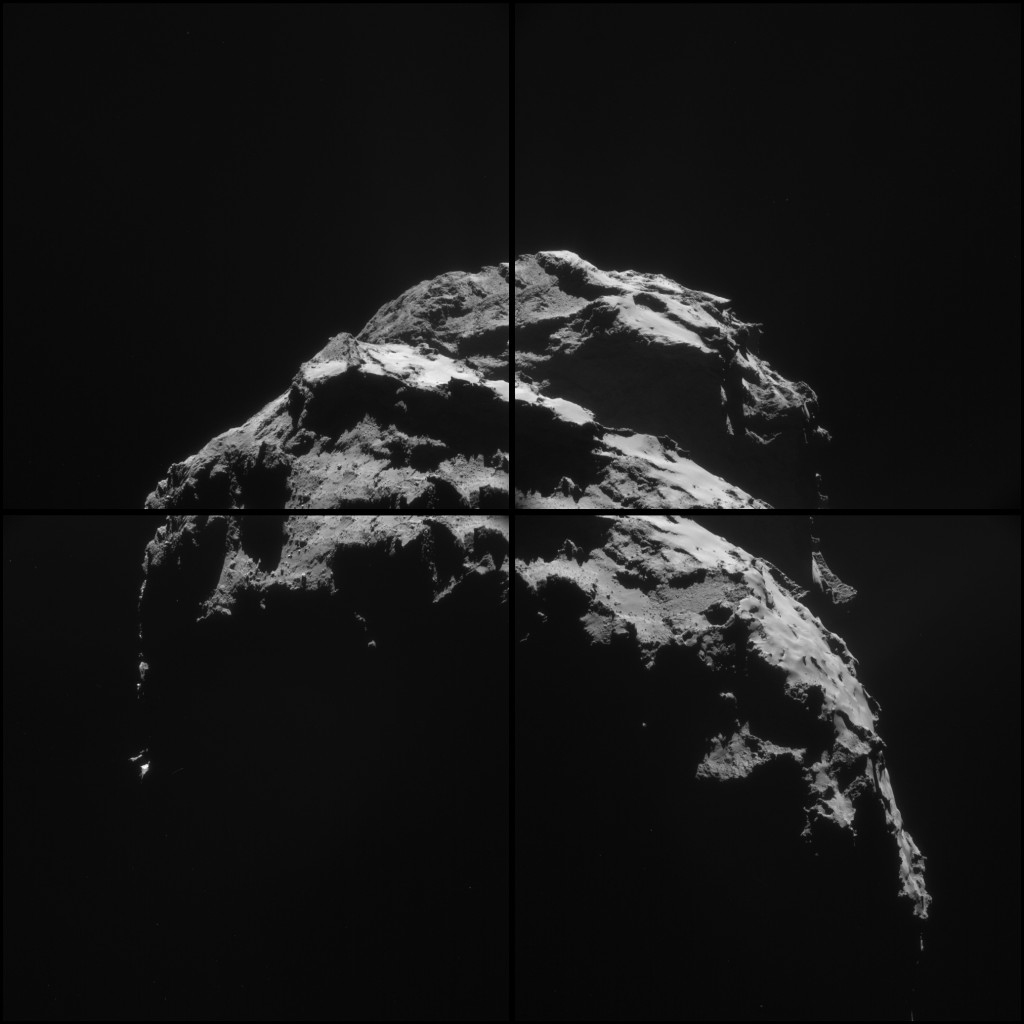
Montage of four images of Comet 67P/Churyumov-Gerasimenko taken on 26 January 2015 by Rosetta’s Navigation Camera (NAVCAM). Credits: ESA/Rosetta/NAVCAM – CC BY-SA IGO 3.0
Rotation and translation of the comet during the imaging sequence often make it difficult to create accurate mosaics out of the four NAVCAM images. But this time we found it impossible to make one without excessively distorting the comet’s features and thus we’re just posting the montage. The image provides a nice view across the comet’s larger lobe (foreground) and up onto the smaller lobe.
The montage is centred on Aten, a region on the larger lobe that extends diagonally from the bottom part of the upper left frame to the top part of the lower right frame, below the prominent cliffs that separate Aten from the brighter Babi region.
In the two lower frames, the Imhotep region on the underside of the larger lobe is cast in shadow. Portions of Babi, Khepry, and Ash are visible on the larger lobe, and parts of Ma’at and Bastet can be seen on the smaller lobe.
You can find regional maps of Comet 67P/C-G here and here to help you find your way around the images.
The four individual 1024 x 1024 frames are provided below:

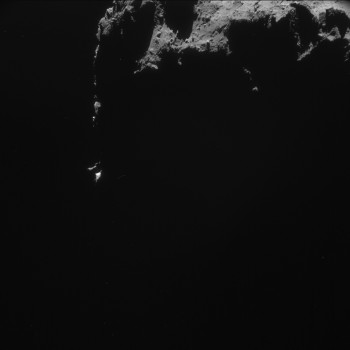
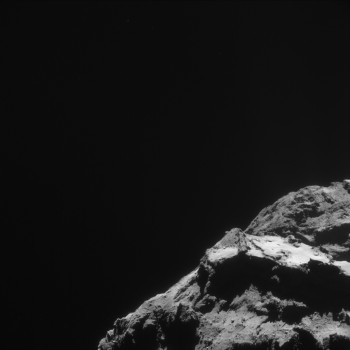
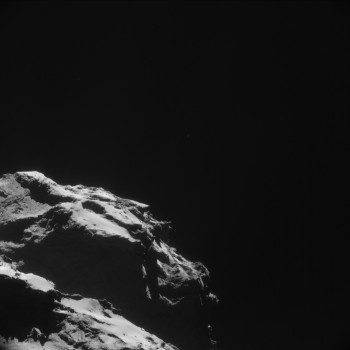
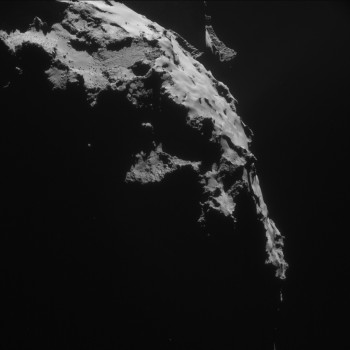








Discussion: 16 comments
Hi Claudia, Emily, and Matt Taylor–
It would REALLY help if you could release an updated and more detailed 3D model of the nucleus. The model released ~3 months ago is out of date compared to the 3D models shown in the papers from Science.
Not only would this help those of us interested in following the Rosetta mission, but nothing gets kids more excited than letting them hold a 15-cm #D print of the nucleus. It’s the best public outreach there is!
–Richard
I have made a shapemodel that might work in the meantime. It has better fidelity than the one released by ESA.
https://mattias.malmer.nu/2015/02/shapemodel-update-2/
On making use of my very short memory, some areas look ‘skinned’, then not, then yes again… Are these the ‘mirages’ commented by Robin?
Thank you Claudia for this image.
Items of interest.
1. The area of the Bastet region on the head lobe we can see, (Image B, top), seems to be made up of many steps as multiple cliff slippages have occurred and the comet material slides down the side of the head lobe towards the higher gravity of the neck region.
2. The vertical scarp that marks the boundary of the Aten and Babi region, (Image B and C), is illuminated just enough to see this is an eroded overhang very similar to the Hathor cliff face, which can also be sen in image C. We can see the comet surface goes right up to the base of the cliff and appears very bright and largely dust covered. Activity propelling this dust from the surface looks to have scoured this cliff into an overhang, the energy density of the dust flow decreasing with height from the surface.
3. What is this feature?
https://www.flickr.com/photos/124013840@N06/16264801998/in/photostream/
It looks similar to a mud volcano on Earth, a mini volcano with a cone, crater and what, at some time, appears to have been semi-molten material flowing out of it. Other features surrounding the Imhotep depression appearing similar to this have been seen in other images. On 67P the fluid must have been liquid volatiles mixed with dust and organics to make a dark, gooey mud that froze soon after reaching the surface. The result of a small very fast moving impact or internal sublimation processes? Take your pick.
Why the hexagonal shape ?
I think it’s not the first time I see hexagonal shapes on some closeups of the surface.
Indeed.
Educated guess time. Crystallisation of the freezing volatiles is sufficient to determine the shapes of solid materials, perhaps? The tiny dust grains are bound within the crystal structure. The complex organic molecules are larger and would more likely, either create or sit in fracture planes.
Many have long commented, including myself, on the polygonal nature, in particular hexagonal, but triangular appears a lot too. Is this just an effect of our brains working overtime to find straight lines in a digital mosaic? I think its genuine pattern recognition by a number of “independent” observers. I look forward to an explanation from the team, as they must have spotted it too.
3. Can’t really say a whole lot with that resolution. The ones in Imhotep are seen in several images and with different angles and a much better example. One of them even seem to have some bright material in it (although as always, it is hard to say what is actually “bright”).
I don’t really have any basis to speculate on though, so I will be content with just observing.
The shape of 67p has been the unsolved puzzle for some time now, and particularly puzzling has been the question why most sublimation is coming from the “shaded valley” -been colder it appears counterintuitive. Now this picture has 67p looking “crustier” than ever, and it makes me think (again) of the surface as the burnt crust of an irregular bun: some process likely caused by suns illumination has created a dry, hard, brittle skin. Harder and denser on the top, more brittle and more porous below. These new images do highlight this structure, plus the collapse and erosion going on. The sublimation of course, mostly come from the originally less baked parts, or from randomly formed bigger cracks: that would be somewhat similar to picking the crumb from a loaf of bread (yes I’ve tried that) .
I like your analogy Jacob. 67P has been continuously undergoing the process of freeze drying, another way of saying, rapidly cooked by removing the volatiles. In addition, an extra boost of energy periodically from the Sun. “Burnt” would be a very apt description.
The analogy with bread really appeals. The comet is shrinking from the inside as well as from the surface. The surface “crust” is going to buckle and crack. The very brittle, volatile depleted, consolidated material making up the crust seems very prone to structural failure;- cliff slides, possibly huge chunks flying off, thermic shock continually making cracks and fissures, rubble slides, It is a surface, in places, sculpted and carved by the dust storm leaving the surface of the comet with ever increasing ferocity as the comet gets nearer to the sun.
The comet is absorbing a lot of energy with that ultra efficient non reflective surface. Some of that energy must, however slowly or fast, be reaching well below the surface. The Rosetta team are able to tease this information out by combining the results from several instruments. Hopefully the thermal conductivity profile. Now that the primary characterisation has been completed, some more mechanical properties, chemical makeup, fluxes and energy densitiy details are going to be calculated from the data one hopes.
Phillae has provided some ground zero data from four different sites “at least”. Professor Monica Grady from the Ptolemy team and Dr Caroline Porco of Voyager and Cassini fame from NASA, appear on BBC Radio 4 and discuss all things solar system exploration. A few little nuggets about Phillae and the chemistry results from Ptolemy. The link is to BBC iPlayer, but the podcast version is extended.
https://www.bbc.co.uk/programmes/b050zy3x
Here’s a link to a paper talking about crust formation —
https://people.virginia.edu/~rej/papers-old/Strazzu-icarus91.pdf
I like the bread crust analogy. There’s what bagels do when they get steamed; or the crust that forms while loaves are resting — a very smooth crust; v.s. the more interestingly patterned crust that forms when you slash the resting crust to let the bread expand while it bakes. Same basic composition, different kinds of heating environment (slow/fast, wet, dry), different final appearance.
Thank you Judy! The rest of you: if you haven’t done it already, read the little article.
1) it brings references to a future “Rosetta” mission
2) it describes a laboratory experiment, the outcome of which gives central clues to the basic structure (and stability) of a cometary mantle. Plus a discussion of implications for this mission.
3) it dates 1990
Like this tread a lot Jacob, Robin, Judy. Two years not eating gluten. Would love to! I could almost walk around Robin’s landscape. Only detail I leave to you is that as soon as a crust is formed, bagels keeps cooking from the hot plate up.
Hi Jacob
Interesting article a little old, perhaps you missed this one that has a completely different morphology. Much more catatclismic. Also the article is a bit old.
For a comet with the wrong water, the wrong surface material and the absence of a fluffy snow core, then may be this will fit the bill
https://metaresearch.org/solar%20system/eph/eph2000.asp
I knew I was too tough on you in my first response (got moderated) Maybe this one will pass the test?
I disagree with you, that the 1990 article central points have been made obsolete by water under the bridge. Certainly IF 67p finally turns out to be dry as a bone BELOW SURFACE TOO, which would be in contrast to every accepted theory and observation up till now, the article has no relevance in this instance (still it would not lessen the work presented)
Nor do I find, that the spectacular, discarded idea of a missing, blown up planet has any real relevance apart from its “action appeal”. But if someone likes action – and not the opposite – accretion and the slow baking of freezing, micron sized layers in a tiny chamber, under vaccum is not the show to go to I realize 😉
My take on this mosaic. It was indeed difficult to stitch all the 4 pictures together and there are some artifacts.
https://www.flickr.com/photos/105035663@N07/16316162209/
Great work from Thomas! Evident is that some brilliant, upper ‘facets’ experienced recent ‘superficial’ sublimation, while others experienced ‘profound’ stress fracturing and significant permanent mass loss.